|
 |
 |
Soil
Preparation
| |
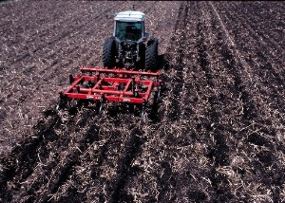
(Source: USDA - National Resources Conservation Service)
|
Prior to planting, the soil needs to be prepared, usually by some form
of tillage or chemical "burn-down" to kill the weeds in the
seedbed that would crowd out the crop or compete with it for water and
nutrients. Tillage methods can be divided into three major categories,
depending on the amount of crop residue they leave on the surface. Residue
slows the flow of runoff that can displace and carry away soil particles.
- Conventional tillage - Until the last decade or so
the standard tillage practice for corn was use of the moldboard
plow for primary tillage followed by several secondary tillages
and mechanical cultivation after the crop was up. Now about two-thirds
of row crops are planted without use of the moldboard plow (Allmaras
et al., 1997), and mechanical cultivation is often limited to one, or
no operations.
- Reduced tillage is usually done with a chisel
plow and leaves 15% to 30% residue coverage on the soil.
- Conservation tillage leaves at least 30% residue
coverage on the soil. Conservation tillage methods include no-till,
where no tillage is done at all and seeds are placed directly into the
previous season's crop residue; strip-till, in which only the narrow
strip of land needed for the crop row is tilled; ridge till; and mulch
till.
Herbicides are used in all these methods to kill weeds.
In no-till systems, the herbicide is applied directly on last season's
crop residue. In the other methods, some soil preparation takes place
before the herbicide is applied. A common myth is that more herbicide
is used with conservation tillage methods, but in fact farmers rely on
herbicides for weed control under all tillage systems, and the amount
used is more or less independent of tillage method.
Soil Preparation Operations and Timing
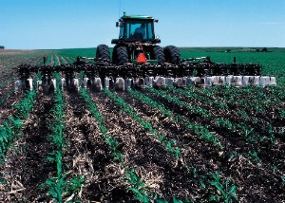
(Source: USDA - National Resources Conservation
Service) |
Tillage can occur anytime between harvest of the previous year's crop and
spring planting. In the eastern Corn Belt,
most tillage is usually done between March and May for corn, and can be
as late as early June for soybeans. In some cases, tillage is done in the
fall, after harvest. In southern states, planting can be considerably earlier
or later because of their longer growing season. The optimum time for tillage
(to prevent soil erosion) is just before planting. However, wet spring weather
can often make it difficult to get equipment into the field as early as
needed to optimize yield. Late planting can seriously reduce yields. For
example, in the eastern corn belt, corn yields are reduced by 1 bu/acre
for each day after May 1 that planting is delayed.
Back to Top
Equipment Used for Soil Preparation

|
| Farm tractor and tillage implement |
| (Source: Daniel R. Ess,
Purdue University) |
Tractor - a traction machine that provides mechanical,
hydraulic, and/or electrical power to implements to perform a wide range
of crop production and handling operations. Tractors are most often used
to perform drawbar work (pulling
equipment through the field) and PTO
(power take-off) (power to rotate equipment components) work. Tractors can
be equipped with rubber tires, rubber belts, or steel tracks. A modern farm
tractor is almost always equipped with a diesel engine and tractor size
is measured by the amount of power that the tractor can produce at the PTO.
Tractor sizes range from those with less than 40 PTO horsepower to ones
that produce more than 400 horsepower. The cost of a large modern tractor
can be well over $200,000.
| 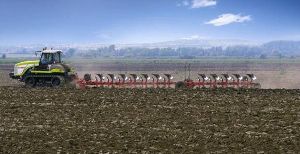
|
Rubber-tracked tractor and
moldboard plow at work in the field. |
| (Source: farmphoto.com) |
Plow - an implement used to perform primary tillage. A
number of types of plows are in common use including the moldboard plow,
the chisel plow, and the disk plow.
The moldboard plow has a large
frame that is equipped with a series of “bottoms,” each of which consists
of a steel coulter to slice through residue followed closely by a steel
share that cuts the soil and an attached moldboard that is used to raise
and turn over the cut “slice” of soil.
Disk plows work in a similar manner to laterally displace
and invert soil through the use of concave steel disk blades.
Chisel plows use curved shanks
to penetrate and “stir” the soil without inverting a soil layer. Chisel
plows cause less residue disturbance than moldboard plows and are often
used in conservation tillage systems.
Disk Harrows (or Disk) - are implements that uses steel
blades to slice through crop residues and soil. Disk blades are mounted
in groups or gangs that rotate as they move forward through the soil.
Front gangs move soil toward the outside of the disk while rear gangs
move soil back toward the center of the disk. A disk can be used for primary
or secondary tillage.
| A close-up view of a disk harrow in the field.
|
 (Source: Deere Photo Library, Vol. 1)
(Source: Deere Photo Library, Vol. 1) |
| A field shot of a tractor and disk harrow at
work. |
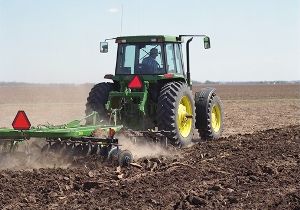 (Source: Deere Photo Library, Vol. 1)
(Source: Deere Photo Library, Vol. 1) |
| 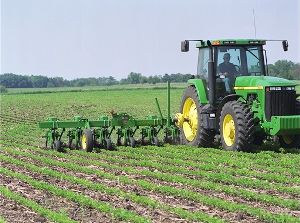
|
A tractor and row crop cultivator
working in soybeans plated
with a conservation tillage system. |
| (Source: Deere Photo
Library, Vol. 1.) |
Field Cultivator -an implement used to perform secondary
tillage operations such as seedbed preparation and weed eradication. Field
cultivators are equipped with steel shanks that are typically spring mounted
to permit the shank to move within the soil and shatter clods. Field cultivators
are constructed similarly to chisel plows, but are more lightly built. Large
chisel plows can exceed 50 feet in width in the field.
Back to Top
Environmental Concerns Related to Soil Preparation:
Soil Erosion

(Source: USDA - National Resources Conservation
Service) |
The major environmental concern related to soil preparation is erosion.
Soil erosion is a natural process that occurs when the actions of water
and/or wind cause topsoil to be removed and carried elsewhere.
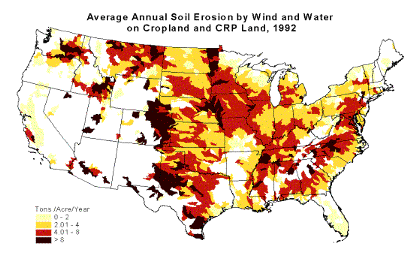
Source: USDA-NRCS |
Soil erosion can be caused by either water or wind.
In many agricultural areas, soil is eroding at a rate of several tons
of soil per acre per year or higher. The map shows an estimate of total
soil erosion on agricultural areas in 1992. This includes both cropland
and set-aside land in the Conservation Reserve Program. Forested and urban
land is not included in the map.
The good news is that soil erosion in the U.S. is decreasing. From 1982-1997,
soil erosion declined about 40% in the U.S., due to government conservation
programs, technological advances, and extension education efforts.
Water erosion is caused by the erosive power of raindrops
falling on the soil (particularly if the soil is not covered by vegetation
or residue) or by surface runoff. Raindrops cause the less severe forms
of erosion (know as sheet and interrill erosion). Severe erosion problems
such as rill erosion, channel
erosion, and gully erosion can
result from concentrated overland flow of water.

Source: USDA-ARS |
Wind erosion is particularly a problem in windy areas when
the soil is not protected by residue cover. Wind erosion in the United States
is most widespread in the Great Plains states, as can be seen in the map
at right. Wind erosion is a serious problem on cultivated organic soils,
sandy coastal areas, alluvial soils along river bottoms, and other areas
in the United States.
Impacts of soil erosion
Soil erosion has both on-farm impacts (reduction in yield and farm income)
and off-farm impacts (contaminated water due to the sediment and associated
contamination from nutrients and pesticides carried on the soil particle).
On-farm impacts due to the loss of soil and nutrients
include:
- lower fertility levels
- development of rills and gullies in the field
- poorer crop yields
- less water infiltration into the soil
- more soil crusting
- more runoff in the spring and after storms
When fertile topsoil is lost, nutrients and organic matter needed by
crops often are removed along with it. Erosion tends to remove the less
dense soil constituents such as organic matter, clays, and silts, which
are often the most fertile part of the soil. However, the loss in productivity
caused by erosion has not been so evident in many parts of the U.S., since
it has been compensated for over the years by improved crop varieties
and increased fertilization.
Soils can tolerate a certain amount of erosion without adverse effects
on soil quality or long-term productivity, because new soil is constantly
formed to replace lost soil. This tolerable level is known as "T" and
generally ranges from 3 to 5 tons per acre per year. Goals for reducing
soil erosion often use the "T" value as a target, because erosion rates
below T should maintain long-term productivity of the soil.
Off-farm impacts occur when the eroded soil is deposited
elsewhere, along with nutrients, pesticides or pathogens that may be attached
to the soil. The tolerable"T" value described above does not take into
consideration the off-farm or downstream impacts. Soil eroded by water
has effects such as:
- eroded soil deposited in depressions and adjacent fields
- decreased water quality downstream
- decline of downstream aquatic ecosystems because of sedimentation
and the addition of nutrients, pesticides, and bacteria associated with
the soil
- clogged drainage ditches and other costly problems
Off-farm impacts of wind erosion are due to the blowing soil, which can
reduce seedling survival and growth (seed cover), increase the susceptibility
of plants to certain types of stress, contribute to transmission of some
plant pathogens, and reduce crop yields. Dust affects air quality, obscures
visibility which can cause automobile accidents, clogs machinery, and
deposits in road ditches, where it can impact water quality.
Back to Top
Best Management Practices to Reduce Erosion
 (Source: USDA - National Resources Conservation
Service)
(Source: USDA - National Resources Conservation
Service) |
Conservation tillage leaves at least 30% residue cover
on the ground. This simple, low-cost practice can have a huge impact on
the amount of soil eroded. Because of energy savings and obvious improvements
in soil quality that can result from conservation tillage, it has been widely
adopted across the Midwest. In Indiana, for example, conservation tillage
was used on 50% of corn and 80% of soybean acres in 2000, a dramatic improvement
from 10 years earlier. There is still room for improvement, however. This
map shows the percent of U.S. crop land currently in conservation tillage.
Percentages are generally higher for soybeans than for corn or other crops.
| Contour farming and strip cropping is
the practice of planting along the slope instead of up-and-down slopes,
and planting strips of grass between row crops. |

(Source: USDA - National Resources Conservation Service) |
| Cover crops are crops such as rye
that grow in late fall and provide soil cover during winter. By providing
a cover to the soil, winter soil erosion from both air and water can
be greatly reduced. |
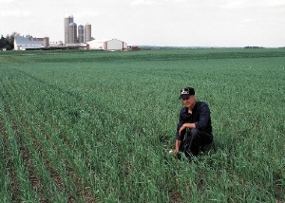
(Source: USDA - National Resources Conservation Service) |
| Grassed waterways protect soil against
the erosive forces of concentrated runoff from sloping lands. By collecting
and concentrating overland flow, waterways absorb the destructive
energy that would otherwise cause channel erosion and gully formation.
|
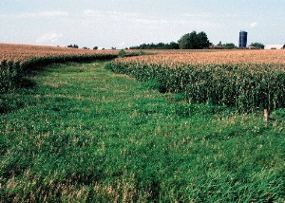
(Source: USDA - National Resources Conservation
Service) |
| Terraces are structural practices
that can reduce erosion by holding back the water and routing it along
a channel at a lower velocity to where it can be safely discharged,
usually into a grassed waterway. |
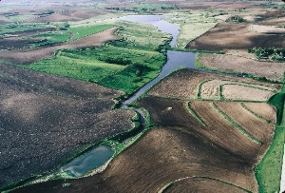
(Source: USDA - National Resources Conservation Service |
| Windbreaks are the best way to protect
soil from wind erosion. They can be in the form of rows of shrubs
or trees. |
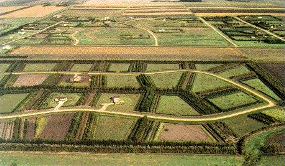
(Source: USDA - National Resources Conservation Service) |
| Windbreaks |
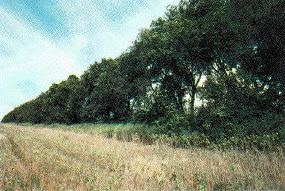
(Source: USDA - National Resources Conservation Service) |
| Grass barriers can prevent wind erosion
by slowing the wind. |
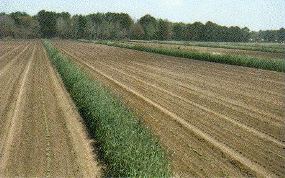
(Source: USDA - National Resources Conservation Service) |
| "Living snow fences" prevent
wind erosion by slowing the wind. |

(Source: USDA - National Resources Conservation Service) |
Photos courtesy of USDA-Natural Resources Conservation Service, except
for the four pictures for practices controlling wind erosion, from the
ARS Wind Erosion
Unit. 
Maps from USDA-NRCS "State
of the Land." 
Back to Top
 Back
to Crop Production Menu Back
to Crop Production Menu
|

